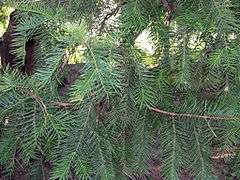Torreya
| Torreya Temporal range: Middle Eocene - Recent 45mya - 0 | |
|---|---|
 | |
| Torreya nucifera | |
| Scientific classification | |
| Kingdom: | Plantae |
| Division: | Pinophyta |
| Order: | Cupressales |
| Family: | Taxaceae |
| Genus: | Torreya Arn. |
| Species | |
| |
| Synonyms | |
Torreya is a genus of conifers comprising six or seven species placed the family Taxaceae, though sometimes formerly placed in Cephalotaxaceae.[2] Four species are native to eastern Asia; the other two are native to North America. They are small to medium-sized evergreen trees reaching 5–20 m, rarely 25 m, tall. Common names include nutmeg yew.[3]
The leaves are spirally arranged on the shoots, but twisted at the base to lie in two flat ranks; they are linear, 2–8 cm long and 3–4 mm broad, hard in texture, with a sharp spine tip.
Torreya can be either monoecious or dioecious; when monoecious, the male and female cones are often on different branches. The male (pollen) cones are 5–8 mm long, grouped in lines along the underside of a shoot. The female (seed) cones are single or grouped two to eight together on a short stem; minute at first, they mature in about 18 months to a drupe-like structure with the single large nut-like seed 2–4 cm long surrounded by a fleshy covering, green to purple at full maturity. In some species, notably the Japanese Torreya nucifera ('kaya'), the seed is edible. Natural dispersal is thought to be aided by squirrels which bury the seeds for a winter food source; any seeds left uneaten are then able to germinate.
The genus is named after the American botanist John Torrey.
Species
- Torreya californica
- †Torreya clarnensis[4]
- Torreya fargesii
- Torreya grandis
- Torreya jackii
- Torreya nucifera
- Torreya taxifolia
Torreya californica (California torreya) is endemic in California. It is the largest species, reaching 25 m tall. One species, T. clarnensis, has been described from Middle Eocene fossils found in the Clarno Formation of Central Oregon, USA.[4]
T. taxifolia (Florida torreya or gopher wood) has a restricted habitat within Torreya State Park, along the east bank of the Apalachicola River in the Florida Panhandle and immediately adjacent southernmost Georgia.
References
- ↑ Camp, W. H.; Rickett, H. W.; Weatherby, C. A. (1947). "International rules of botanical nomenclature, Appendix III: Nomina Generica Conservanda". Brittonia. 6 (1): 1–120 (Section 10, page 47). doi:10.2307/2804665.
- ↑ Christenhusz, J. M. M.; Reveal, J. L.; Martin, F. G.; Robert, R. M.; Chase, W. M. (2011). "Linear sequence, classification, synonymy, and bibliography of vascular plants: Lycophytes, ferns, gymnosperms and angiosperms" (PDF). Phytotaxa. 19: 1–134.
- ↑ Eckenwalder, J.E. 2009. Conifers of the World: The Complete Reference. Timber Press.
- 1 2 Manchester, S.R. (1994). "Fruits and Seeds of the Middle Eocene Nut Beds Flora, Clarno Formation, Oregon". Palaeontographica Americana. 58: 30–31.
- Gymnosperm Database: Torreya
- Native Conifers of North America: Torreya
- Pinetum.org: photos of Torreya californica
- Pinetum.org: photos of Torreya nucifera
- Proposals for Torreya taxifolia re-establishment
- Torreya State Park (Florida)